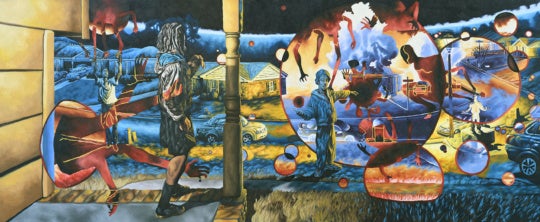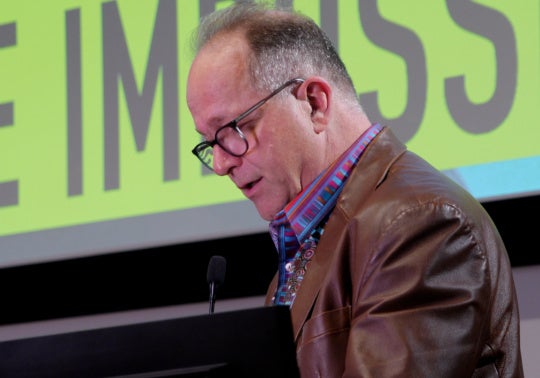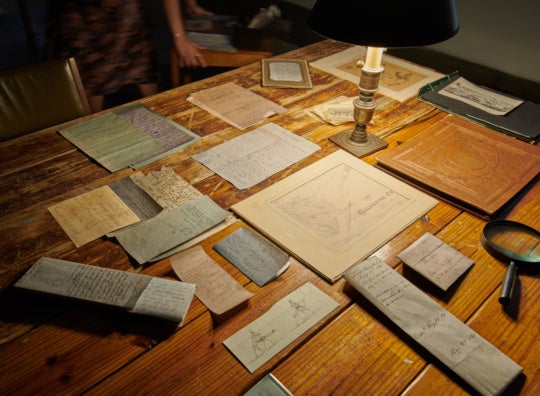
You may have heard about, or even stayed at, a 21c Museum Hotels, the boutique hotel chain and art museum founded in 2006 in Louisville. It was the brainchild of art collectors and entrepreneurs Laura Lee Brown and Steve Wilson, who wanted to combine their love of art, food, and history with a strong commitment to placemaking and urban revitalization. In the broader contemporary art community, the model was met with a mix of anticipation and curiosity, perhaps tinged by skepticism. More than a decade later, there are now seven 21c locations, including Cincinnati, Bentonville, Durham, Lexington, Oklahoma City, and Nashville, with Kansas City and Miami in the works, and the art in the boutique hotels often rivals that of the museums in each city.
We talked to longtime 21c Museum director and chief curator Alice Gray Stites about how the hotel museum model works, what it’s like to show museum-quality works in, essentially, a 24-hour public space, and how art-savvy and unwitting hotel guests respond.

Eileen Yanoviak: Even though people are now familiar with 21c and it continues to grow—what is your elevator pitch for such a unique model? How do you explain the relationship between the art and the business?
Alice Gray Stites: 21c Museum Hotel was founded by people who are passionate about providing access to thought-provoking contemporary art and to creating a sustainable model for doing so. The art is at the heart of 21c and why it exists at all. We consider it a multi-venue museum, now with over 75,000 square feet of exhibition space spread across seven cities, but a single entity. The operations of the museum are supported by the hotel and restaurants.
“We have had some success in converting those who perhaps are a little cynical about contemporary art.”
When Steve Wilson and Laura Lee Brown founded 21c in 2006, their desire was to provide greater access to contemporary art, but also to support the role of culture in the revitalization of downtown cities, investing in the urban core. They didn’t want to open a private foundation or private museum that would be dependent on admission tickets, memberships, donation, and the continued largesse of future generations. They did a study about what kind of business would possibly thrive in downtown Louisville in the early 2000s, and the answer was the city needs more hotel rooms. They’re passionate about food and the sustainability of agriculture in Kentucky, so they also wanted to open a chef-driven restaurant. That model has seemed to work well in each of the cities where 21c is located. But I like to say that the art is integral to the mission of the company and integrated deeply into everything we do.

The 21c collection started off as the private collection of Steve Wilson and Laura Lee Brown. How has the collection evolved over time?
That is a layered question. What began as a personal passion for collecting has evolved into a public mission within an unconventional institution. The 21c collection had about 1,000 works when we opened and has expanded to around 3,000 objects in the permanent collection which we augment with loans. I think the collection has also grown in depth and in character so that you can describe it as very much a humanist perspective on art. It’s work about the human experience—very much a global one because there are so many artists from all over the world, so there is a curiosity about the variety of experience and identity embedded in the collection.
“We are 21c—twenty-first century—so I think it’s important that we be among the first to support visionary artists who are using, for example, technology in new ways.”
There are artists that have been collected in more depth as the collection has grown. We have been identifying which artists we think are really seminal to the kinds of programs we have and the kinds of exhibitions we put together for the public. There’s a consistent interest in new and emerging artists. So, you see people who are really well-known, like Kehinde Wiley, with artists who are just beginning to emerge onto the scene, like Hassan Hajjaj and some others in this show. We continue to always look at what artists are experimenting with. We are 21c—twenty-first century—so I think it’s important that we be among the first to support visionary artists who are using, for example, technology in new ways. For example, the collection includes two virtual reality pieces, one by a British duo called Skullmapping and the other by Jakob Kudsk Steensen, which will be included in the upcoming “The SuperNatural” exhibition at 21c Durham, and I just installed Claudia Hart’s Flower Matrix, an augmented reality wallpaper.

You’ve been with 21c for a long time. How have you participated in the trajectory of this collection?
It’s an incredible privilege to work this closely with collectors, whom I met originally in my role at the Speed Art Museum many years ago. They were very involved in supporting contemporary art there. Almost ten years ago, I first began travelling with Laura Lee and Steve to art fairs and galleries and going on studio visits and having conversations. Originally, I was just there to be supportive, but now when we are considering new acquisitions most of our conversations are what exhibitions are we working on, is that exhibition going to travel, what would you use this for? They are really focused on supporting the program of the museum and the kinds of exhibitions that we want to develop. And they are both incredibly knowledgeable and actively involved in helping to flesh out those ideas, such as what are some of the relevant things happening in the world we should try to address?

That’s interesting because I know that some collections that were built largely by the vision of one or two people—say Alice Walton at Crystal Bridges—have very specific approaches and interests. It can in some ways limit the institution, but in other ways can give a great amount of depth. Has there been that kind of give-and-take in this collecting relationship?
I think what’s really special about their approach is the breadth of it. They are driven by an intense curiosity to discover the new and an appreciation for the complexity of contemporary art and the layered and nuanced visions that artists have. That allows for a tremendous breadth, and a real dedication to supporting that work that is most compelling. You get the best of both worlds. It’s really fun to have worked alongside them for so long. Sometimes there are days when Steve and I will send each other an email announcement about an artist at the same time. Laura Lee was in Brazil a few years ago and I told her that one of the artists in the collection, Albano Afonso, was having a solo show at his gallery there. She wrote that there were two works she thought would be really good for an exhibition I was working on, and they were the exact two pieces that I thought would be so fantastic to have. And that show led to him getting a solo show at the Contemporary Arts Center in Cincinnati. It’s a terrific kind of synergy.

That’s an amazing privilege to have. In some respects, you also have some flexibility and limitations that come with the model. How much do you want to comply with traditional museum standards versus keeping the flexibility you are allowed by not being a museum?
We like to say we want to uphold museum standards, but we don’t have to play by all the museum rules. Which means that because we want to both be part of the broader global conversation that institutions are having. We want to be able to borrow work from both private and public collections, so we need to maintain standards of humidity and temperature, which can be a challenge in old buildings. But luckily, it’s not at odds with how the hotel is maintained for the comfort of our guests. We do allow people to browse the galleries anytime they want, to carry a glass of wine. So, to counterbalance the potential damage to works of art that the conventional museum world would think was crazy, we invest a great deal more in staff training. That is the magic. Anyone who works at any 21c in any capacity participates in staff training on all of the exhibitions. We don’t ask everyone to know everything about the show, but we mostly want to share as much as I know, and as much as my team knows, about the art. So, people feel passionate and engaged and take a sense of ownership over the art for which they are essentially being ad hoc custodians and docents. And then they share whatever nugget they have taken with them with guests. It makes the experience so much more memorable.
“Anyone who works at any 21c in any capacity participates in staff training on all of the exhibitions. “
We definitely want to participate and collaborate with other institutions, and we do, on programming. In Louisville, 21c is a part of the Cultural Pass. as well as Idea Festival and the Photo Biennial. In Cincinnati, we have become very involved with the FotoFocus program. 21c was the hub of their programming last time, and I co-curated a show with Kevin Moore, who is the curator of FotoFocus. We find that most institutions, museums especially, are a lot more flexible and are looking for new opportunities. We all want to be more than we have been in the past. I am grateful for that.
Another way that we are upholding museum standards is by presenting, writing about, and discussing the works from a serious point of view. We don’t take everything seriously, but wehave to take the artist’s vision seriously. We want the artists to take pride in being part of the collection or the exhibition.

By not following the traditional museum model, I would assume you attract an audience that is not always prepared for a contemporary art experience. How do you handle those guests and what are your goals?
It depends on the nature of the interaction. These may be people who are booked at a 21c because that’s where their company put everyone. They know nothing. I might not have a direct interaction with them, but somebody at the front desk will. Those front desk staff are trained to tell them, “This is a museum, here’s what’s going on, and this is our show.” Some people wander around and take it in by osmosis. One of my favorite things to do is to linger around and listen to people talking about the art and hearing groups of people say, “There’s always something new down this hallway, we need to look here.” I think it sparks a curiosity even if they don’t know what they are looking at. So, they go on a voyage of discovery, and hopefully they come back. We have public tours that bring in a mixture of hotel guests and the community. We get people who come for every show, the lectures, and the programming. We have had some success in converting those who perhaps are a little cynical about contemporary art.
When it comes to the regional art scene, how does 21c engage with regional artists and connect them with a broader international art scene?
Through a variety of ways. I want to talk not about Louisville as the flagship, but about opening locations in new cities. You don’t want to arrive in a new city and say, “This is what contemporary should be,” ignoring what is probably a vibrant community to begin with—which has been absolutely true. So, we started a program called Elevate at 21c. The architects designed space on each of the guest-room floors to showcase art from the community or region. That program is largely curated by the museum manager, and I work with them to identify artists whose work we borrow for a period of about 4-6 months. That’s a way of both bringing art into the building from the get-go, before we have had a chance to really get to know the community, and it exposes their artwork to people staying at the hotels. We’ve had instances of guests loving the artwork, then asking to be put in touch with the artist or their gallery. We’ve had numerous instances of having discovered an artist through the Elevate program and then borrowing his or her work for one of our travelling exhibitions, and in some cases acquiring the work. In the case of two artists in Cincinnati who work together under the name Future Retrieval, we commissioned them to do a very large site-specific permanent installation for 21c Durham after getting to know them and showcasing their work in Cincinnati.

That’s an amazing way to get buy-in from the community. You also do programs, lectures, and art-related events. I’ll wrap up with asking you about your new show “Pop Stars!” What’s that about and where did the idea originate?
Pop Stars! Popular Culture and Contemporary Art—the exclamation point is working kind of like a double entendre because, while there are images of a lot of pop stars like Britney Spears, Charlize Theron, Michael Jordan and others in the show, it’s more about how pop culture is now a star—the star—of contemporary art. Looking back at Pop art of the 1960s, it used to be a way of addressing the division between the vernacular and fine or high art. Today, I would argue that as we delve deeper into the digital age and the virtual and the real are colliding, those distinctions no longer exist. Popular culture has become an apt subject matter through which to address interesting and important questions around politics, the economy, gender relations, science, and the impact of technology on the way we live today. We see artists invoking the visual language of historical or religious iconography as a way to frame investigations into contemporary culture—how it’s being created and how it’s being consumed, specifically around this idea that our popular culture is driven by an obsession with celebrity and driven by consumerism.
Eileen Yanoviak is a PhD Candidate in Art History at the University of Louisville and Adjunct Faculty at the University of Arkansas at Little Rock. She is also Membership Manager at the Speed Art Museum in Louisville, Kentucky.




